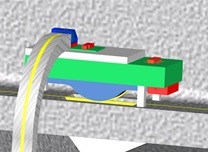Project description
As a tribute to the continuously increasing volume of data traffic, optical waveguides have become a serious alternative to electrical circuitries. The potential of precise space-resolved strain measurements or the capacity to transmit very large amounts of data are two examples of the beneficial use of optical systems. Apart from the general advantages of the optical signal line, like high electromagnetic compatibility, usage in explosive atmosphere or the reduced weight compared to copper cables, modern technologies make use of the possibilities to integrate optical waveguides into structural components.
Advanced manufacturing technologies e. g. for the integration of optical waveguides into fiberglass composite components or into printed circuit boards are subject of current research. However, several topics, like the signal transfer at nods in photonic networks, are still unsolved. There are possibilities of optical-electrical and electrical-optical signal conversion. Though an exclusively passive coupling of optical signals is currently subject to restrictions. The market for optical data transmission is growing fast and will still increase in the future. Optical waveguides theoretically enable bitrates of more than 100 Tbit/s, what is physically impossible by using copper conductors. However, the usage of optical waveguides on board level is mostly limited to 2D applications. Boards have to be interconnected by additional glass fiber cables or specific board connectors. As a result, the freedom of design and the potential for miniaturized and integrated components is restricted by the complex setup. Additionally, the number of optical junctions is increasing the optical loss. Therefore, 3D printing processes are investigated to enable a fully automated manufacturing of integrated optical waveguides.
The main goals of the DFG founded research group will be:
- development of a technical printing process for coating surfaces with lateral structural resolutions of less than 1 μm for the subsequent application of optical waveguides
- technology for manufacturing optical waveguides on 3D-formed surfaces in order to implement the guidance of optical signals on a structural component
- passive concept of coupling for a subsequent division of the optical signals along the optical path of the optical fibers during field mounting
- concept of coupling for the direct connection of optoelectronic converter components to the optical fibers during the manufacturing process in order to promote the monolithic integration of optical system components
- process for the production of 3D wave-guiding structures for the integration of highly compressed diode arrays at a microscopic level and their coupling to optical waveguides at the macroscopic level
- computer-aided methods for the design and simulation of 3D-opto MIDs.
Further information available on: http://www.optaver.de/startseite/startseite.html


